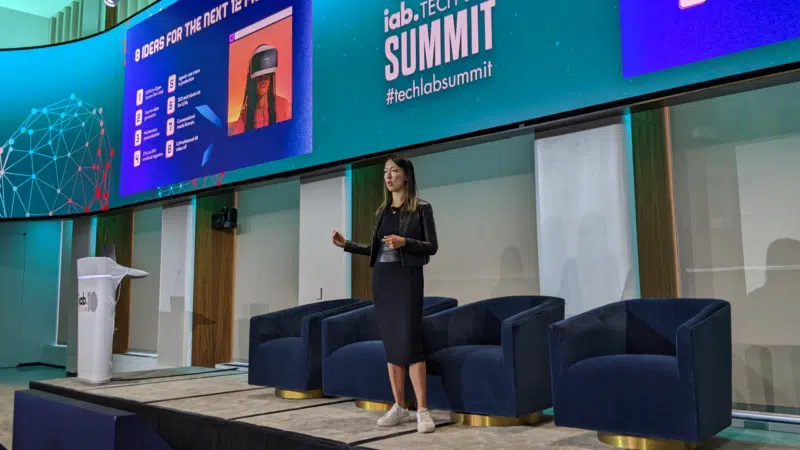Salesforce’s AI CEO explains why this new AI wave is different
Insights into improved genAI-powered sales, customer experience and advertising from the IAB Tech Lab Summit in New York.

It seems like every day new AI-powered tools enter the growing martech ecosystem. At the IAB Tech Lab Summit in New York this month, tech leaders discussed real applications for the technology, either available now or soon.
The theme of the conference, “The End of the Beginning: Nothing Will Be the Same,” was fitting. Marketers are catching their breath from a flood of updates and new features. The next step is to determine how new AI capabilities will change the way marketers and advertisers reach customers.
Advertising’s new upsides
The digital advertising industry is creating new ways to reach addressable audiences in a post-cookie world through data collaborations, data clean rooms and retail media networks. Matching ads to the right consumers isn’t directly dependent on generative AI in many of these use cases, but scaling up creative and testing ads is.
Clara Shih, CEO of Salesforce AI, explained how new LLMs can potentially improve on testing, which ensures that optimal ads find the right consumers.
“In A/B testing, traditionally the A variant and B variant were defined by humans,” said Shih. “Now, if they are machine-defined, you can have…thousands of possibilities (in creative), all the way to backgrounds (in the creative).”
Shih cited a recent Coca-Cola campaign that used GPT-4 and DALL-E to generate new ads from existing brand assets. Consumers were invited to use the engine to create ads with the best one getting shown on a Times Square billboard.
Shih also pointed out that LG Electronics is using genAI to speed up ad production. Previously, a new product would have to be included in separate production shoots for each of 80 markets. Now those elements can be customized according to parameters in an LLM that make ads that are culturally relevant for each market without having to create each ad from scratch.
“There are profound implications in terms of the speed, the cost, the talent that’s required to make that happen,” Shih said.
Dig deeper: Google unveils AI-powered advertising tools at Google Marketing Live
Performance optimization for digital ads
Meta is using AI to string together or “chain” an optimal sequence of content for users on Instagram Reels. Shih said this advancement led to a double-digit increase in view time, proving the effectiveness of AI-powered recommendations.
“Conventional wisdom is that we’ve spent the last decade building these very large specialized machine learning models for everything from ad serving to newsfeed serving to video serving — something we didn’t question. But, researchers started to experiment with LLMs to see if they can outperform (the ML models), and in fact that’s what happened,” said Shih. “LLMs are outperforming larger, specialized models, which is very counterintuitive.”
Dig deeper: Meta rolls out genAI features for advertisers
Personalized experiences
GenAI-powered chatbots support a deeper engagement when customers trust them enough to ask them for help on a specific task. Queries that users input can help build better understanding by the LLM. The result is that LLMs can support better-personalized experiences. Where will these new capabilities lead in terms of personalized experiences? This is where chatbots could become even more fleshed-out avatars in digital experiences.
“There have been various attempts at creating these ‘metaverse’ or AR experiences,” Shih explained. “Now with generative AI, we’re very close to making this much easier to do, much more automated. Just like the examples of a genAI-created image or video, or text being generated. A personalized avatar to be a part of that means you really understand that individual.”
This deeper engagement can lead to achieving “that holy grail of the segment of one while being compliant with privacy regulations,” Shih said.
Shih added: “There’s a downside to deepfakes, but what does it mean when each of us has our own avatar to represent us in our decisions? What does it mean when each of the consumers we’re targeting has one, and that avatar becomes a gatekeeper for the content, whether paid or earned, that they consume?”
With the capacity of genAI chatbots to have detailed conversations with customers and show an understanding of consumers’ needs, lower-funnel activities will be possible.
“Instead of sending a consumer to a website, you will be able to do commerce within the LLM probably very soon,” said Shih. “Lines are starting to blur from ads to marketing to commerce, sales and customer service,” said. “In the post-cookie world, traditional silos that existed in our world are tending to melt away.”
Contributing authors are invited to create content for MarTech and are chosen for their expertise and contribution to the martech community. Our contributors work under the oversight of the editorial staff and contributions are checked for quality and relevance to our readers. MarTech is owned by Semrush. Contributor was not asked to make any direct or indirect mentions of Semrush. The opinions they express are their own.
Related stories
New on MarTech